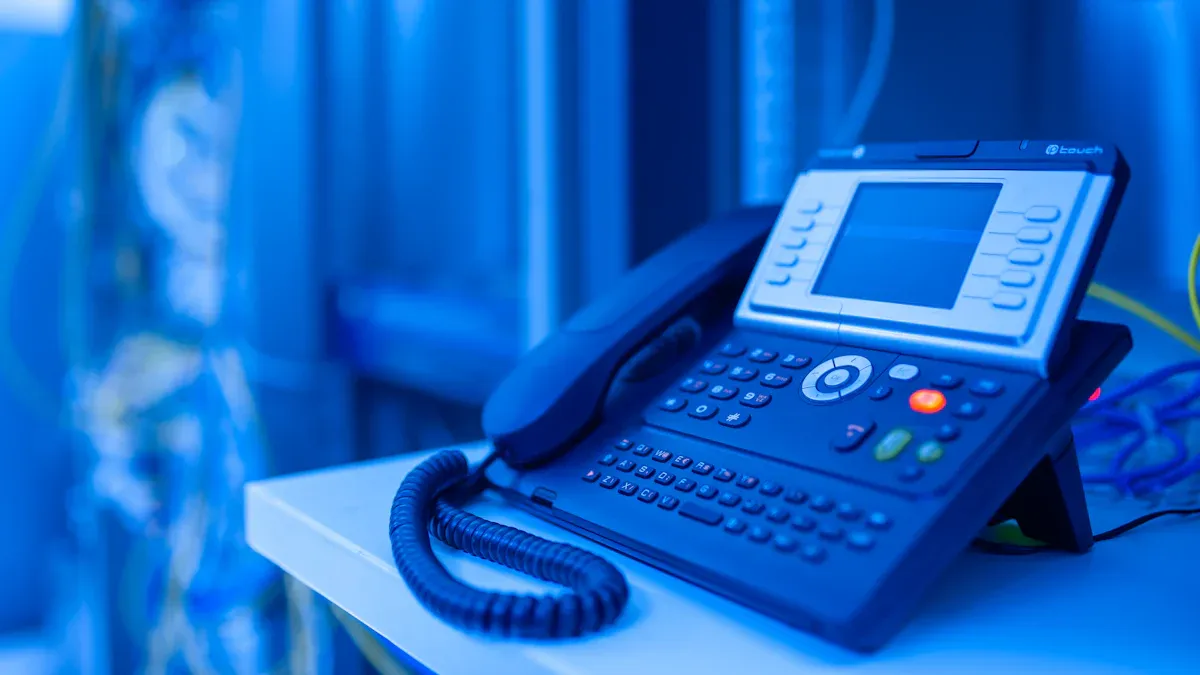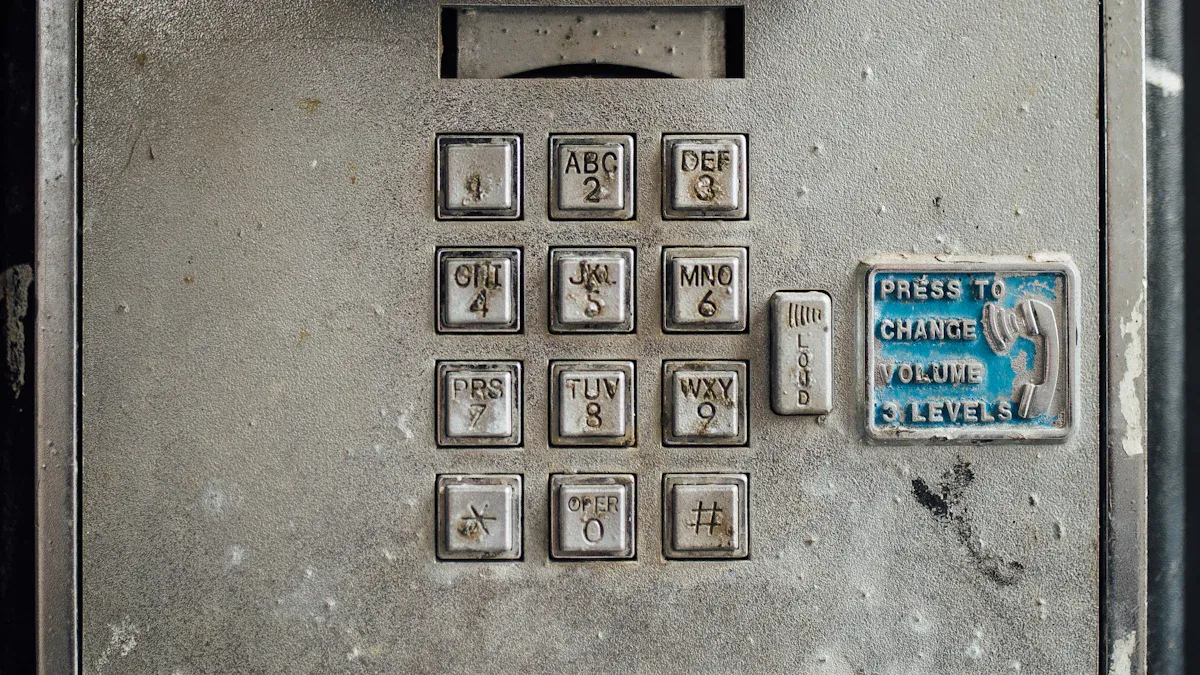
Explosion Proof Telephones play a vital role in ensuring safety in hazardous environments. Industries like mining and oil refineries rely on these emergency Explosion Proof Telephones to maintain communication under extreme conditions. The global market for ATEX Explosion Proof Telephones reached $320 million in 2022 and is growing at 5.2% annually, driven by stricter safety regulations and rising demand for reliable mining Explosion Proof Telephones.
Key Takeaways
- Check the dangerous area before starting. Learn about the chemicals and environment to stay safe and follow rules.
- Pick the correct explosion-proof phone for your area. Make sure it can handle weather and works with your system.
- Get ready by collecting the right tools and reading the manual. Good planning makes the job safer and faster.
Step 1: Assess the Hazardous Area

Before installing an explosion-proof telephone, it’s essential to evaluate the hazardous area thoroughly. This step ensures the device operates safely and complies with all necessary regulations.
Determine the hazardous area classification
Hazardous areas are classified based on specific criteria. These include the types of chemicals present, their likelihood of being in the area, and their physical properties. The table below outlines these criteria:
| Criteria | Description |
|---|---|
| Types of Chemicals | The specific flammable materials present in the area. |
| Probability of Presence | The likelihood of these materials being present during normal operations. |
| Volume | The amount of chemicals being processed or utilized. |
| Physical Properties | Observations such as concentrations, densities, pressures, and temperatures. |
Understanding these classifications helps identify the right equipment for the job. Explosion-proof telephones are specifically designed for environments where safety and reliability are critical.
Identify environmental factors like temperature and humidity
Environmental conditions can significantly impact the performance of explosion-proof devices. Factors like temperature and humidity must be considered. For instance, these telephones typically operate within an ambient temperature range of -40 to +60 °C and a relative humidity of up to 95%. Ensuring the device matches these parameters prevents malfunctions and extends its lifespan.
Verify compliance with local and international safety standards
Adhering to safety standards is non-negotiable. Compliance not only ensures safety but also improves operational efficiency. For example, a petrochemical plant that upgraded to ATEX Zone 1 compliant equipment reduced downtime by 40% and lowered insurance costs. Similarly, mining operations have seen fewer equipment failures and improved worker safety by meeting these standards. Always verify that the installation aligns with both local and international regulations to avoid penalties and ensure smooth operations.
Step 2: Select the Appropriate Explosion Proof Telephone
Choosing the right explosion-proof telephone is crucial for ensuring safety and functionality in hazardous environments. Here’s how to make the best selection:
Choose a telephone certified for the specific hazardous area classification (e.g., ATEX, IECEx, UL)
Certifications like ATEX, IECEx, and UL validate that a telephone meets strict safety standards for hazardous areas. These certifications ensure the device won’t ignite flammable substances. The table below highlights the key certifications:
| Certification Standard | Description |
|---|---|
| ATEX Certification | Regulates explosion-proof equipment in the EU, ensuring devices prevent ignition in flammable environments. |
| IECEx Certification | Provides a global certification system, ensuring products meet stringent safety requirements for use in explosive atmospheres. |
| UL Certification | Ensures devices meet safety regulations in North America through rigorous testing methodologies. |
To achieve certification, manufacturers submit devices for testing, which includes examining the design, testing under various conditions, and evaluating performance data. Certified telephones provide peace of mind by meeting these rigorous standards.
Consider features like weather resistance, noise-canceling, and durability
Explosion-proof telephones often operate in extreme conditions. Look for features like weatherproof protection rated at IP68, which ensures the device withstands harsh weather. Durable materials, such as impact-resistant GRP, protect against shocks and chemicals like acids or lubricants. Noise-canceling microphones improve sound clarity, even in noisy environments. For example, some models include a ringing volume of 95dB(A) at 1 meter, ensuring calls are heard in loud settings.
Ensure compatibility with existing communication systems and power sources
Compatibility is key to seamless integration. Many explosion-proof telephones support Power over Ethernet (PoE) or alternate power sources. They also work with most SIP-based IP-PBX servers, making them versatile for various industries like refineries and power plants. The table below outlines some compatibility features:
| Feature | Description |
|---|---|
| Power over Ethernet | PoE 802.3af enabled or alternate power source |
| Compatibility | Compatible with most SIP-based IP-PBX servers that comply with SIP RFC 3261 |
| Housing Material | High impact thermoset resin industrial housing, IP-66 compliant |
| Applications | Refineries, Sewage Plants, Power Generation Facilities, Drilling Rigs, etc. |
| Electrical Performance | Network Rate 10/100 Mbps, Power consumption PoE (class0): 2.5 W |
Selecting a telephone with these features ensures it integrates smoothly into existing systems while maintaining safety and reliability.
Step 3: Prepare for Installation
Proper preparation is key to ensuring a safe and efficient installation of an explosion proof telephone. This step involves gathering the right tools, reviewing instructions, planning the site, and determining if additional components are necessary.
Gather approved tools and equipment for hazardous area installations
Using the correct tools is essential when working in hazardous environments. Approved tools and equipment reduce risks and ensure compliance with safety standards. For example, the IECEx Certified Equipment Scheme provides certifications that validate tools for use in explosive atmospheres. The table below highlights some certification schemes:
| Certification Scheme | Description |
|---|---|
| IECEx Certified Equipment Scheme | Reduces testing costs and speeds up market access for products. |
| IECEx Certified Service Facilities Scheme | Ensures service facilities meet international standards. |
| IECEx Certificate of Personnel Competence Scheme | Certifies personnel competence in hazardous environments. |
| IECEx Conformity Mark Licensing System | Provides a mark for compliant equipment. |
By using certified tools, installers can work confidently, knowing they meet international safety standards.
Review the manufacturer’s installation manual thoroughly
Before starting, it’s important to read the manufacturer’s installation manual. This document provides step-by-step instructions tailored to the specific explosion proof telephone model. It also includes safety precautions and wiring diagrams. Skipping this step can lead to errors or unsafe installations. A thorough review ensures the process goes smoothly and avoids costly mistakes.
Plan the installation site for optimal safety and accessibility
Choosing the right location for the telephone is crucial. The site should be easily accessible during emergencies and away from potential hazards. For instance, placing the device in a high-traffic area ensures quick access. Additionally, consider environmental factors like temperature and humidity to prevent damage. Proper planning not only enhances safety but also extends the lifespan of the telephone.
Determine if additional components like isolation barrier units (IBUs) are required
In some cases, additional components like isolation barrier units (IBUs) are necessary. These devices protect against overcurrent and overvoltage, which can cause sparks in hazardous areas. Zener barriers, for example, use diodes and resistors to redirect fault currents to the ground, preventing ignition. Isolators, on the other hand, block surges without requiring grounding, offering enhanced safety and reliability. Including these components ensures the installation meets safety standards and operates effectively.
Step 4: Install the Explosion Proof Telephone

Mount the telephone securely using explosion-proof hardware
Proper mounting is critical to ensure the safety and functionality of an explosion-proof telephone. Use explosion-proof hardware, such as bolts and screws, that comply with industry standards. All bolts and screw holes should be blind or bottomed to prevent openings into compartments. This prevents any potential exposure to hazardous elements. Additionally, locks or seals should be installed to prevent tampering with spark-producing parts. Following these guidelines ensures the telephone remains secure and safe to use in hazardous environments.
| Guideline | Description |
|---|---|
| Mounting | All bolts and screw holes must be blind or bottomed to prevent openings into compartments. |
| Tampering Prevention | Adequate locks or seals must be provided to prevent unauthorized access to spark-producing parts. |
Run wiring through approved conduit and junction boxes (e.g., ANSI/UL 1203 standards)
Wiring must be routed through approved conduits and junction boxes to maintain safety and compliance. Standards like UL 1203 ensure that electrical equipment is explosion-proof and dust-ignition-proof. These standards are essential for hazardous locations. For example, the third and fourth editions of UL 1203 are widely recognized for their stringent safety requirements. Using these approved components minimizes the risk of sparks or ignition.
| Standard | Description |
|---|---|
| UL 1203 (Third Edition) | Standard for Explosion-Proof and Dust-Ignition-Proof Electrical Equipment for Use in Hazardous Locations, approved for § 111.105-9. |
| UL 1203 (Fourth Edition) | Standard for Safety: Explosion-Proof and Dust-Ignition Proof Electrical Equipment for Use in Hazardous Locations, approved for §§ 111.106-3(b) and 111.108-3(b). |
Connect the wiring as per the manufacturer’s instructions
Following the manufacturer’s instructions is essential for safe and effective wiring. Manufacturers provide detailed wiring diagrams and guidelines to ensure proper installation. These instructions often specify the cable types and techniques required for electrical safety. For example:
- Ensure electrical connections match the provided wiring diagrams.
- Use the recommended cable types to maintain safety and performance.
- Follow installation techniques to prevent equipment failure or ignition risks.
Adhering to these steps ensures the telephone operates reliably and safely in hazardous conditions.
Test the device to ensure proper functionality and safety
Once installed, testing the explosion-proof telephone is the final step. This involves checking all connections, ensuring the device powers on, and verifying its communication capabilities. Testing also includes inspecting the hardware for any loose components or potential hazards. A functional test ensures the telephone operates as intended, providing reliable communication in emergencies. Regular testing after installation further enhances safety and compliance.
Step 5: Verify Safety and Compliance
Inspect the installation for adherence to safety standards and regulations
Inspecting the installation ensures the explosion-proof telephone meets all safety standards. This step is crucial for preventing hazards and ensuring long-term reliability. Installers should check several key aspects:
- Bolts and screw holes must be blind or bottomed to avoid openings into compartments.
- Battery cells should be housed in explosion-proof compartments or locked to prevent tampering.
- Signaling devices, like those using electric light bulbs, need safety mechanisms or explosion-proof enclosures.
- Devices must include standby power sources to function during power outages.
- Manufacturers’ installation instructions should be followed to ensure compliance.
Thorough inspections also involve testing compartments with explosive mixtures to verify their safety. These checks confirm the installation is both adequate and permissible under safety regulations.
Conduct a final functionality and safety test
After the inspection, a final test ensures the telephone operates as intended. This includes verifying the device powers on, checking communication clarity, and testing emergency features. Installers should also confirm that all safety mechanisms, such as tamper-proof locks and standby power, function correctly. Testing under simulated hazardous conditions can provide additional assurance. A properly tested telephone guarantees reliable performance during emergencies.
Document the installation process for compliance and future reference
Proper documentation is essential for compliance and maintenance. Installers should record every step of the process, including inspection findings and corrective actions. The table below highlights key documentation practices:
| Documentation Practice | Description |
|---|---|
| Installation Instructions | Adequate instructions must be provided for the installation and connection of devices. |
| Maintenance Records | Detailed records including inspection dates, findings, and corrective actions are essential. |
| Inspection Protocols | Thorough inspections and tests are required to ensure adequacy and compliance with standards. |
| Compliance Verification | Records must verify compliance with regulatory standards to demonstrate due diligence. |
Keeping these records ensures the installation complies with regulations and provides a reference for future maintenance or audits.
Maintenance Guide for Explosion Proof Telephones
Perform routine visual inspections for damage or wear
Routine inspections are essential for keeping an explosion-proof telephone in top condition. These checks help identify any visible damage, wear, or malfunction that could compromise safety. Inspect critical components like wiring, seals, and protective enclosures. If issues arise, address them immediately to prevent further problems.
Your maintenance program should include regular inspections, testing, and servicing of the ATEX equipment. This involves checking for any signs of wear, damage, or malfunction that could compromise the equipment’s safety or compliance. Inspections should be thorough and cover all critical components, wiring, seals, and protective measures. Any issues identified should be promptly addressed through appropriate repairs or replacements.
Clean the device using approved methods to prevent dust or debris buildup
Dust and debris can interfere with the performance of explosion-proof telephones. Cleaning the device regularly with approved methods ensures it stays operational. Use non-abrasive materials and avoid harsh chemicals that might damage the protective casing. Keeping the device clean also reduces the risk of ignition in hazardous environments.
Test the telephone periodically to ensure operational reliability
Periodic testing confirms that the telephone functions as intended. Check the audio clarity, power supply, and emergency features. Testing under simulated conditions can provide additional assurance. Regular tests ensure the device remains reliable during emergencies.
Replace worn or damaged components promptly
Worn or damaged parts can compromise the safety and functionality of the telephone. Replace these components as soon as possible to maintain compliance and operational reliability. Using certified replacement parts ensures the device continues to meet safety standards.
Maintain detailed records of inspections, repairs, and maintenance
Accurate records are vital for compliance and safety management. Maintenance logs should include inspection dates, findings, corrective actions, and parts replaced. These records demonstrate due diligence and ensure accountability during audits or emergencies.
- Detailed maintenance records are essential for compliance management in explosion-proof environments.
- They include inspection dates, findings, corrective actions, parts used, and compliance verification with regulatory standards.
- Regular inspection reports should include dates, details, findings, corrective actions, and inspector names.
- Maintenance logs must detail repairs, work performed, parts replaced, and technician names.
Train personnel on proper use and maintenance procedures
Proper training ensures personnel can use and maintain the telephone safely. Teach them how to inspect, clean, and test the device. Training also helps them recognize potential issues early, reducing the risk of accidents. Well-trained staff contribute to the long-term reliability of the equipment.
Installing explosion-proof telephones becomes simple when following these five steps. Regular maintenance keeps them reliable and safe.
Tip: Adhering to safety standards not only ensures compliance but also extends the device’s lifespan.
By using this guide, industries can maintain secure communication in hazardous environments, protecting both workers and operations.
FAQ
What makes explosion-proof telephones different from regular telephones?
Explosion-proof telephones are designed to prevent sparks or heat that could ignite flammable substances. They meet strict safety standards for hazardous environments like ATEX or IECEx.
Can explosion-proof telephones work in extreme weather conditions?
Yes! Many models are weatherproof with IP68 ratings, allowing them to function in harsh conditions like heavy rain, extreme heat, or freezing temperatures.
How often should explosion-proof telephones be inspected?
Routine inspections should occur every 3-6 months. Regular checks ensure the device remains safe, functional, and compliant with safety standards.
Tip: Always follow the manufacturer’s maintenance schedule for optimal performance and safety.


